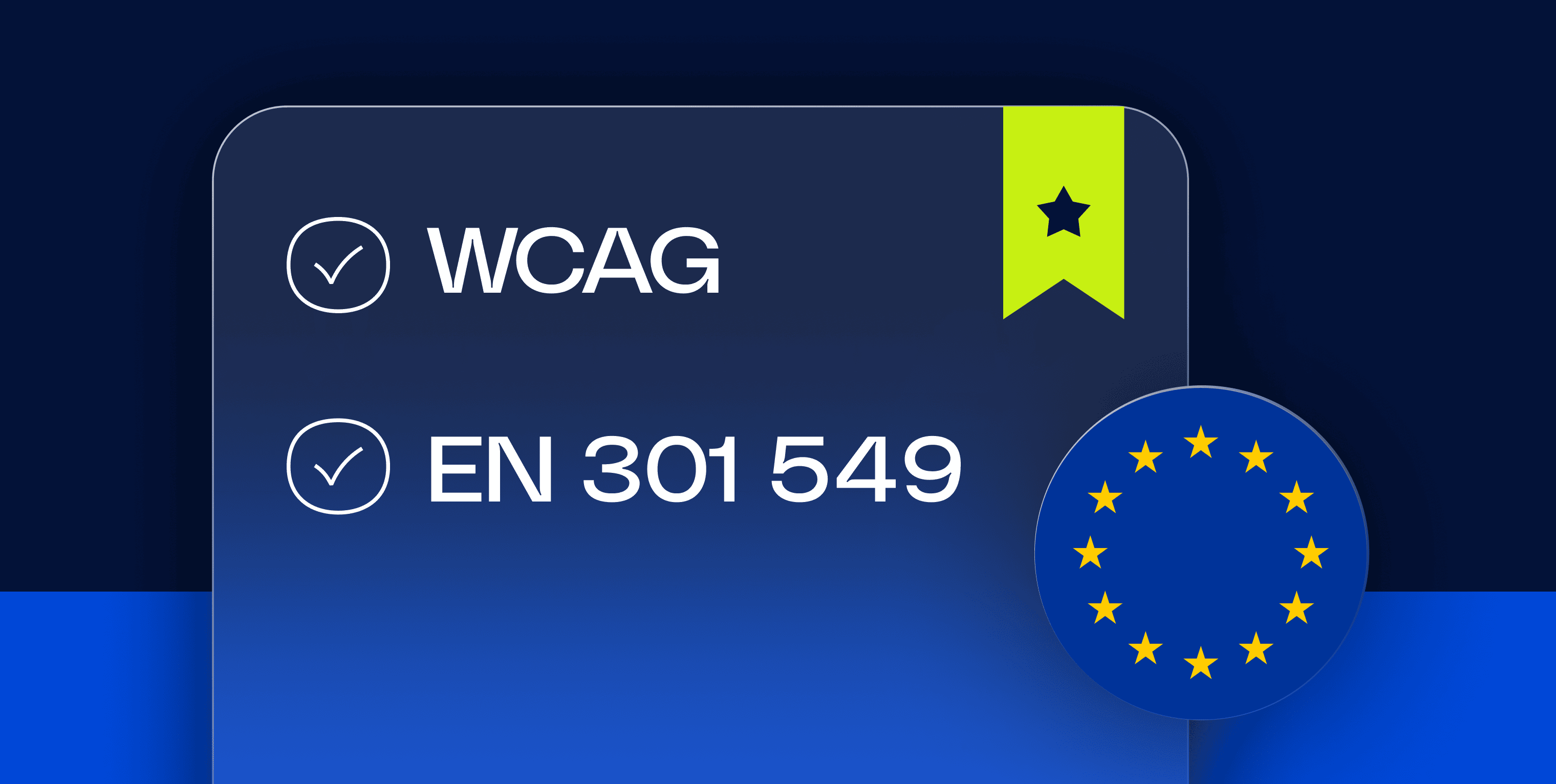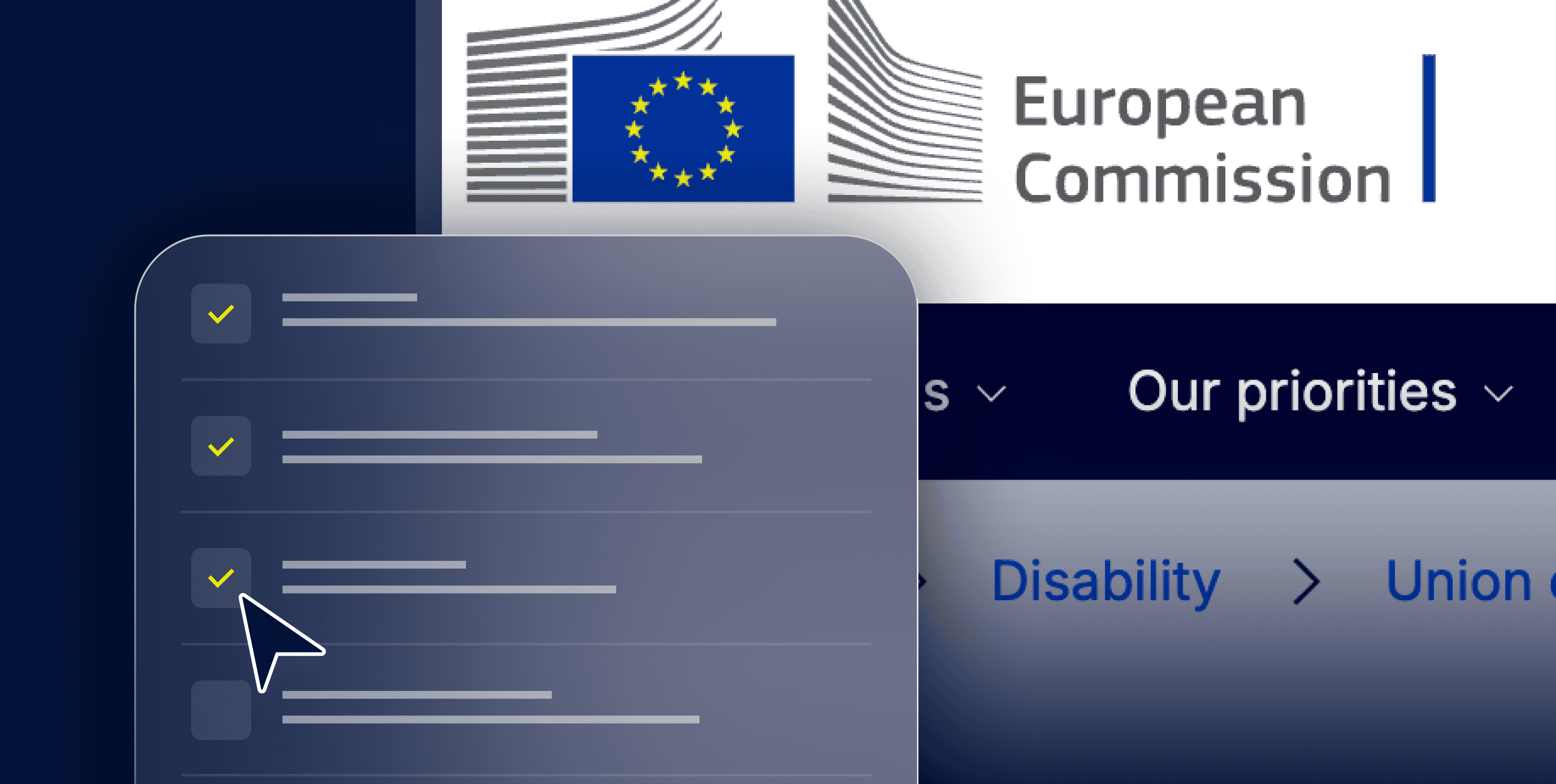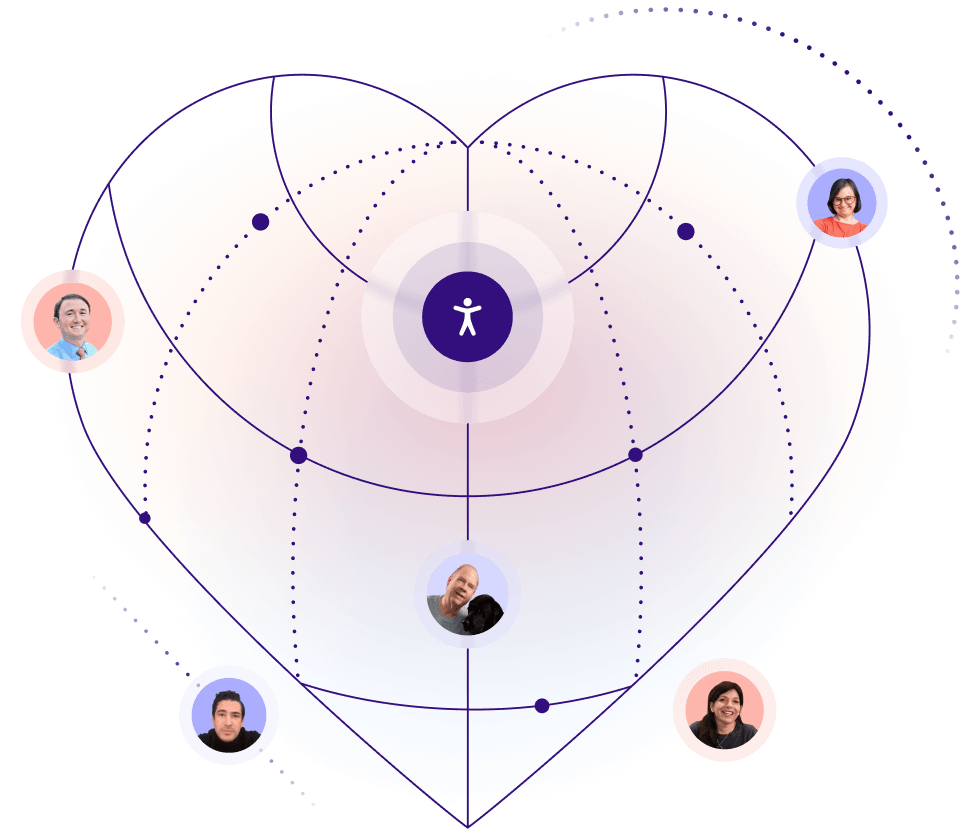First off: What is the EAA and how do you know if it applies to you?
The European Accessibility Act (EAA) was adopted by the European Union in 2019 to improve access to key digital products and services for people with disabilities.
While the public sector has been subject to web accessibility requirements under a separate directive since 2016, the EAA extends similar obligations to private businesses operating in the EU.
Private-sector organizations must ensure that covered products and services, such as websites, apps, e-commerce platforms, banking services, and more, are accessible across all EU member states.
Businesses that fall under the EAA
The EAA doesn’t apply to every business or every digital offering. Its scope is defined by two key factors:
Let’s break each category down:
Does your business offer EAA-covered services or products?
If your business operates in the EU and offers certain digital products, services, or supporting technologies, you may be required to meet accessibility requirements. These include:
- Online stores or digital marketplaces
- Mobile or web-based banking services
- Phone, messaging, or internet-based communication tools
- Streaming platforms or audiovisual content services
- E-books or dedicated e-reading software
- Ticketing, booking, or real-time transport information systems
- Self-service terminals, such as check-in kiosks or payment machines
- Consumer tech products like smartphones, operating systems, or set-top boxes
Is your business large enough to be included?
The EAA applies to companies it categorizes as enterprises. Organizations with fewer than 10 employees and less than €2 million in annual turnover are considered microenterprises, and will likely be exempt from the EAA’s service-related requirements.
However, if you manufacture products covered by the EAA – such as smartphones, payment terminals, or other consumer tech – you may still need to meet certain accessibility obligations, even if you qualify as a microenterprise.
Who enforces the EAA?
Each EU member state is responsible for enforcing the EAA through its own national laws and regulatory bodies. These authorities are empowered to monitor compliance, handle complaints, and issue penalties – including fines, service restrictions, or public notices of non-compliance.
To find out which agency is responsible in your country, the European Commission maintains a directory of national contact points and implementation updates.
Bottom line:
- If you're a private business based in the EU, or offering digital products and services to EU customers, and your offerings fall under the EAA, accessibility requirements likely apply
- Depending on the country, failure to comply may lead to fines or public enforcement actions issued by local authorities
What does complying with the EAA actually entail?

So, now that we've established what the EAA is and who it applies to, let's look at what compliance actually involves.
While the EAA does not specify an official standard for compliance (like some other laws do), there are strong indications that EN 301 549 will serve as the reference point across most EU member states.
EN 301 549 and WCAG: your path to compliance
EN 301 549 is a European standard that defines what it means for digital products and services to be accessible. It covers everything from websites and mobile apps to software, hardware, and self-service terminals.
It’s been adopted in EU public-sector accessibility laws for years, and it’s widely expected to be the baseline technical standard used to assess compliance under the EAA as well.
However, when it comes to websites, apps, and other digital content, EN 301 549 doesn't spell out its own detailed rules. Instead, it points to the Web Content Accessibility Guidelines (WCAG).
WCAG is a globally recognized framework developed by the World Wide Web Consortium (W3C), and it serves as a guiding standard for many international accessibility laws - including the Americans with Disabilities Act (ADA) in the United States.
What you need to know about WCAG
The Web Content Accessibility Guidelines (WCAG) are built around four core principles, known as POUR, that define what it means for digital content to be accessible:
- Perceivable – Content should be able to be consumed in different ways (e.g. alt text for meaningful images, captions for video, sufficient color contrast)
- Operable – All functionality should be usable by keyboard or assistive technology
- Understandable – Content and navigation should be clear, consistent, and predictable
- Robust – Content should reliably across modern devices, browsers, and assistive technologies (like screen readers)
WCAG comes in multiple versions - 2.0, 2.1, and 2.2, the most recent to be published.
Each version builds on the one before it, adding new criteria to address evolving accessibility needs, including mobile navigation, low vision support, and cognitive clarity.
Additionally, each version of WCAG offers three levels of conformance:
- Level A – Basic accessibility
- Level AA – The most commonly referenced in legislation
- Level AAA – The highest level, but often difficult to meet across all content
While this can seem complex, here’s what matters:
Conforming to WCAG 2.1 Level AA is widely considered sufficient for meeting the EAA’s digital accessibility requirements.
Taking steps to comply with the EAA: a comprehensive checklist

Complying with the EAA in the form of adhering to WCAG 2.1 Level AA calls for a multi-layered approach; one which involves testing, remediation, and ongoing accessibility maintenance.
To help you in your efforts, here is a checklist of critical action items you will need to address:
Important note: This is a partial list. To conform with WCAG 2.1 Level AA at the necessary level, there are additional guidelines you will need to adhere to.
- Provide alt text to meaningful images
- Ensure text can be resized to 200% without loss of content or function
- Use clear headings and labels
- Add a “Skip to Content” link for easy navigation to the main content
- Provide audio descriptions for video content
- Allow website visitors to control time limits when engaging with interactive elements
- Create clear and helpful web page titles
- Ensure information conveyed by color is distinguishable without color
- Make all website functions accessible for visitors with limited mobility
- Ensure buttons, icons, and menus appear consistently
- Assign the correct language to web pages
- Ensure web elements remain stable when receiving input
- Ensure your website is responsive
- Ensure your website is devoid of content that can trigger seizures
- Indicate language changes in code
- Provide captions for videos with audio
- Allow website visitors to control auto-playing content
- Provide transcripts for audio and video content
- Ensure high contrast between text and background
- Ensure no loss of functionality when adjusting text spacing
- Ensure all website functionality is operable via keyboard
- Ensure website visitors can use either screen orientation
- Provide captions for live videos
- Ensure errors are clearly identified and described in text
accessiBe is here to help

Identifying the gaps in accessibility appearing in your website, let alone remediating them and maintaining ongoing accessibility can be challenging. This especially true with larger, high-traffic, and more complex websites.
Many organizations therefore rely on comprehensive accessibility platforms to help them reach their accessibility and compliance goals.
accessiBe offers a variety of solutions and services tailored to businesses’ unique challenges and needs, designed for fast implementation, aligned with top security practices, and structured to minimize your workload:
Quickly solve accessibility with the power of AI
Quick to install and always-on, accessWidget scans your website, identifying gaps in accessibility. Then, leveraging accessiBe’s patented AI, it applies session-based remediations, enabling screen compatibility and keyboard navigation - core to WCAG conformance.
accessWidget also presents website visitors with an interface through which they can adjust the look and feel of your website to better-fit their unique abilities. With the interface, people with cognitive disabilities like ADHD can stop animations and other visual elements, while people with low vision and other vision impairments can adjust text size and color contrasts.
Businesses with more complex websites can benefit from manual testing and custom remediation.
accessiBe experts will manually inspect key user journeys within your website to better understand the unique accessibility challenges they present. Then, they will enhance accessWidget, ensuring it better-supports these flows by fine-tuning how it responds to specific components, layouts, and user interactions.
Address legal risk with comprehensive litigation support
To help you address legal claims with confidence, if those were to arise, accessiBe offers comprehensive litigation support. Depending on your plan, you can benefit from:
- A dedicated case manager who will help guide as you respond to claims
- Attorney consultation
- €15k+ pledge to help address legal claims, if those arise
To learn more about this, press here.
Solve accessibility at the code level
Organizations looking to build accessible websites and digital environments from the ground up, can do so with accessFlow, an intuitive native accessibility platform. Built to fit seamlessly into existing workflows, accessFlow empowers developers and team leaders to detect, prioritize, and resolve accessibility issues at any stage of your development pipeline.
Additionally, with the introduction of auto-resolve, developers can now leverage accessiBe’s patented AI to quickly resolve lighter accessibility issues on a session-base with a click of a button. A feature unique to accessFlow, autoFox helps accelerate your path to legal compliance, while freeing up developer bandwidth to tackle more serious issues manually.
To learn more about accessFlow, press here.
Let the experts take care of your digital assets
WCAG adherence entails adjusting your website so that it can be accessed by everyone, regardless of abilities. Yet, these requirements extend to other digital assets, as well.
Under WCAG, PDFs (and other online documents) need to be tagged correctly, feature alt text for meaningful images, consist of a proper heading hierarchy, and follow other formatting practices that make them readable by assistive technologies.
If you're dealing with a high volume of PDFs, and/or with online documents featuring dynamic content (like interactive forms, tables, or embedded media), you are best served relying on accessibility experts to help make them accessible.
accessServices can help you address complex online document remediation projects in a timely, cost effective manner.
You can also turn to accessServices for additional accessibility services, such as expert audits of your website, including the option of incorporating people with various disabilities in the testing process. This can help highlight areas that may present challenges to people with specific impairments, so that you can make the necessary adjustments.
The time to take action is now
With the EAA enforced throughout the E.U., it’s more important than ever to make sure you and your business are in compliance with the law.
If you require assistance with this, or would like to discuss solutions tailored to your unique needs and challenges, feel free to schedule a demo with one of our accessibility experts by pressing here.
Frequently asked questions about EAA compliance
Q1. What is the European Accessibility Act (EAA) and when did it become enforceable?
A1. The EAA is a European Union law adopted in 2019 to ensure that digital products and services are accessible to people with disabilities. It became enforceable in June 2025 across EU member states, establishing a common accessibility standard for both public and private sectors.
Q2. Who must comply with the EAA checklist?
A2. Any organization offering covered products or services to EU consumers must comply—including non-EU businesses operating in the EU market. Some micro-enterprises with fewer than 10 employees and under €2 million in annual turnover may be exempt, depending on national implementation.
Q3. Which technical standards underpin the EAA checklist?
A3. The EAA references the European standard EN 301 549, which is closely aligned with the Web Content Accessibility Guidelines (WCAG) 2.1 Level AA. These standards define how websites, mobile apps, software, and other digital products should be made accessible.
Q4. What are examples of requirements listed in the EAA compliance checklist?
A4. Common requirements include adding alt text for images, ensuring keyboard operability, maintaining a minimum 4.5:1 color-contrast ratio, providing captions and audio descriptions for media, supporting text resizing up to 200 percent, and structuring content with clear heading hierarchies and language tags.
Q5. Does the checklist cover mobile apps and other digital products beyond websites?
A5. Yes. The EAA applies to a wide range of digital technologies, including websites, mobile applications, e-books, self-service kiosks, payment terminals, and other ICT interfaces used to deliver goods and services in the EU.
Q6. What happens if an organization fails to comply with the EAA?
A6. Non-compliance can result in fines, removal of products or services from the EU market, exclusion from public procurement opportunities, and reputational damage. National enforcement bodies will have authority to audit and penalize violations.
Q7. How can businesses start implementing the EAA checklist?
A7. Begin by conducting an accessibility audit, mapping existing gaps against the EAA checklist, and prioritizing high-impact fixes. Integrate accessibility reviews into design and development workflows, conduct ongoing monitoring, and document compliance efforts.
Q8. How can accessiBe help organizations achieve EAA compliance?
A8. accessiBe provides a complete accessibility ecosystem that includes AI-powered scanning, automated and manual remediation, expert audits, and documentation support. Tools like accessWidget help bridge accessibility gaps on a session basis, accessServices assist organizations in testing and remediating websites and digital assets, and accessFlow enables developers to create accessible digital experiences at the source-code level—all supporting alignment with the European Accessibility Act and WCAG 2.1 Level AA.





